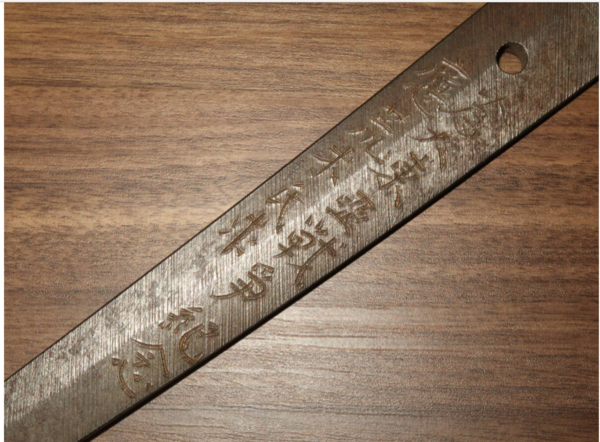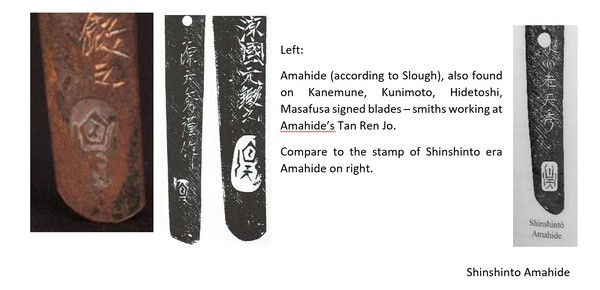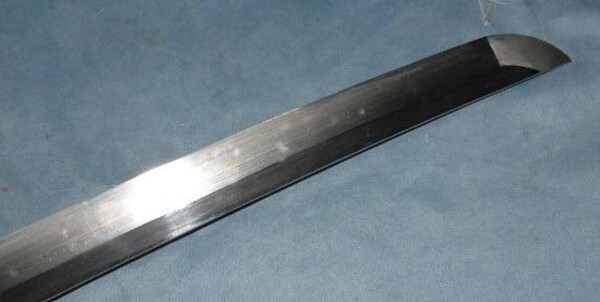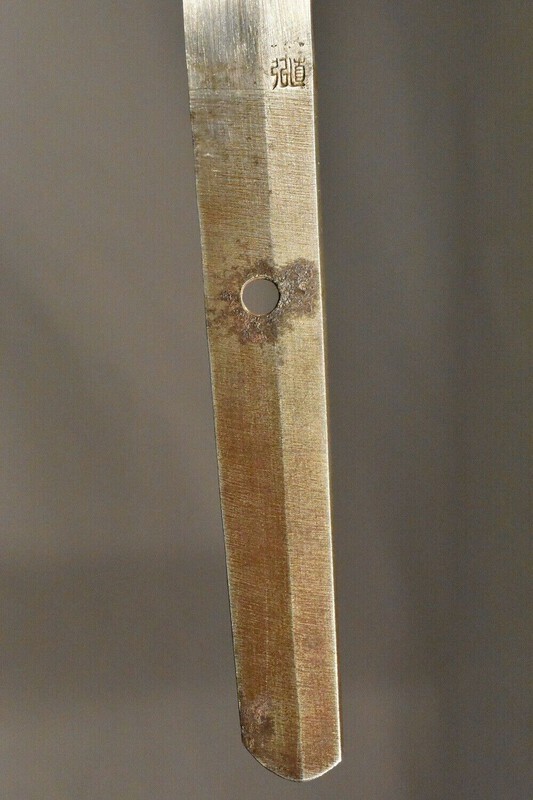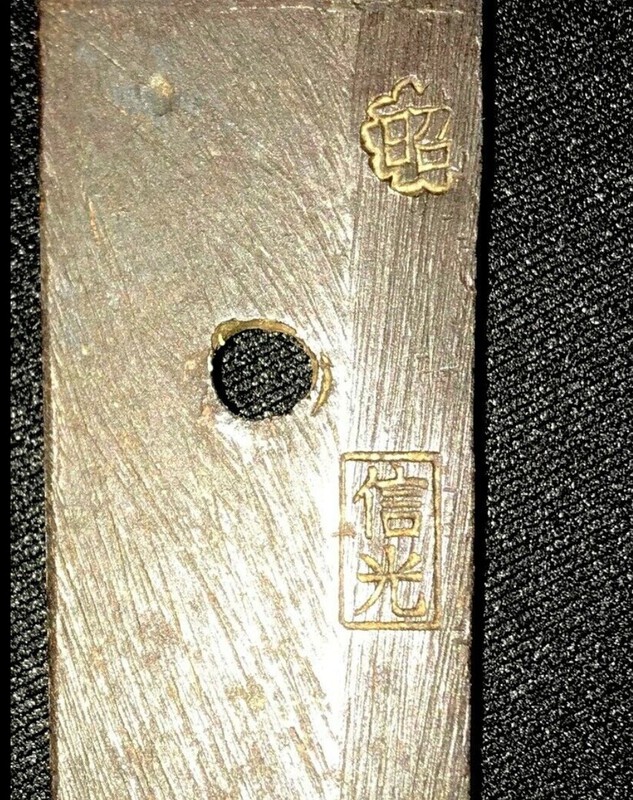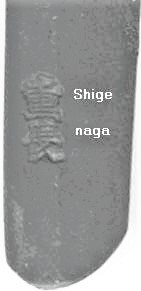-
Posts
13,780 -
Joined
-
Last visited
-
Days Won
169
Content Type
Profiles
Forums
Events
Store
Downloads
Gallery
Everything posted by Bruce Pennington
-
Where did you find that one, Marcel? Here is one I have on file. Found on what Fuller called an "ersatz sword." "The tsuba of an “ersatz” sword possibly made in Manchuria in the last months of the war. 造 could be short for 造兵 which in Japanese apparently translates to "Arsenal."
-
Oooo, could be
-
Sorry buddy, but David is correct. This is a fake.
-
Good question John. Any of your ideas might be the right one. They might have all been part of a batch order given to a particular sword shop to outfit and the numbering system might have been done by the sword shop. But anything is possible. Interesting that you identified a particular system on multiple blades!
-
I have seen quite a few, and several where the tsuka was just plain wood, covered tightly in leather. The tsuba might be a civil one.
-

Gunto with long Chounsai Emura mei
Bruce Pennington replied to Rawa's topic in Military Swords of Japan
Marcin, The black army saya is fairly common. At first glance, I often think "Aha! Another souvenir.", when it's really just another army saya. The metal fittings aren't gold gilded. -
Yes. He, and/or his forge, had his own kokuin that is seen on his blades, but also on 4 other smiths that must have worked at the forge - Kanemune, Kunimoto, Hidetoshi, and Masafusa And yet, we also have one of his blades with an unknown stamp: And a couple blades with his Retired Servicemen's group, Koa Token Sha, kokuin: All this added to these stamped-mei blades!
-

Paired NCR gunto presentation box?
Bruce Pennington replied to buchtas's topic in Military Swords of Japan
Marcin, A mon is a crest, kamon is family crest. We usually just say mon for short. No, the railway emblem is not what we mean when discussing mon. See here: https://www.militaria.co.za/nmb/topic/29606-help-identity-our-mon/?do=getNewComment -
Thanks, Mal! That one seems to be making the rounds. Found it back in 2022 for sale, then again in Sept '24. Always appreciate the tips, though! Autumn '42 Koa Isshin
- 1 reply
-
- 1
-

-

Paired NCR gunto presentation box?
Bruce Pennington replied to buchtas's topic in Military Swords of Japan
Martin, Help me understand your question - Are you asking if presenting swords in high quality cases was a normal practice? Or are you asking if presenting swords to officials, in general, was a normal practice? I personally have not seen them in elaborate cases, but have seen them in plain wooden boxes. I have seen several presentation swords. One in our files was made by the South Manchurian Railway (Mantetsu) and presented to city officials of 3 small towns. Others are found in fancy tachi fittings and were given to railway employees when they reached 25 years of service. Looking forward to seeing the sword and box of your post. -

AUTHENTIC WW2 ERA Japanese KATANA
Bruce Pennington replied to Swords's topic in Translation Assistance
I second that. -
The stamped mei were uncommon, but I have a few on file from 4 smiths: Seven blades from Masayuki 9 Naohiro 1 Nobumitsu and now 2 Shigenaga (this one from JSI) We now have 2 Amahide blades with other smith names stamped at the bottom - Shigenaga and Kanemaru.
-
From Sesko's list: "KANEMARU (金丸), Shōwa (昭和, 1926-1989), Nagasaki – “Kanemaru” (金丸), family name Ogawa (小川), ryōkō no jōi (Akihide), Fifth Seat at the 6th Shinsaku Nihontō Denrankai (新作日本刀展覧会, 1941)"
-
Ok, thanks, Thomas. I see it's one of those situations where more than one English word can be used for the Japanese word. I'll leave the Stamps doc terminology as is, and use the terms interchangeably in discussions.
-
Ken, You Tenshozan blade has navy tsuba/seppa (hand guard and spacer) but an army saya (scabbard). Don't know who matched them up that way, but it wouldn't have been that way originally. The second is in army fittings. The wooden saya originally would have had a leather cover. Check the brown tassel for any signs of faded blue or red. If none, then this sword was carried by someone in the Gunzoku, the civilian branch of the army.
-
Books and time. It will come along. Books won't help much with stamping, though. If you don't have it already, download Stamps of the Japanese Sword, for the latest info.
-

AUTHENTIC WW2 ERA Japanese KATANA
Bruce Pennington replied to Swords's topic in Translation Assistance
This is not a WWII blade, Derek. All I recognize is "Masa". Have to wait for the real translators for the rest. -

Info needed possibly looking to sell
Bruce Pennington replied to Rebeccacran's topic in Military Swords of Japan
Michael, The majority of the conversation took place via PM. I announced our conclusion and summary of the issue on this post: -
The common mistake, perpetuated by years of collector folklore, is that the Showa stamp was an arsenal mark. It was not. It was the inspection mark of the civilian organization Seki Cutlery Industry Association (I've been saying "Manufacturers"; but Thomas has it as "Industry". He's the language expert, so "Industry" it is!). They were asked by sword shops/forges to start running inspections because "poor showato were hurting the industry's reputation." These blades were made for both the civilian and military markets. Yes, the massive majority were bought by the military, but many were sold to private shops.
-
Here's a first for me - Patent numbers on Type 98 saya:
-

Mei and "serial number" on saya
Bruce Pennington replied to John C's topic in Military Swords of Japan
Well, call me surprised! Never seen patent numbers on saya before! -

Arsenal Mark on RJT sword Fittings
Bruce Pennington replied to george trotter's topic in Military Swords of Japan
Chris, I updated the post to add the photo with the star. Was in a hurry originally, and didn't notice I'd left it off.








